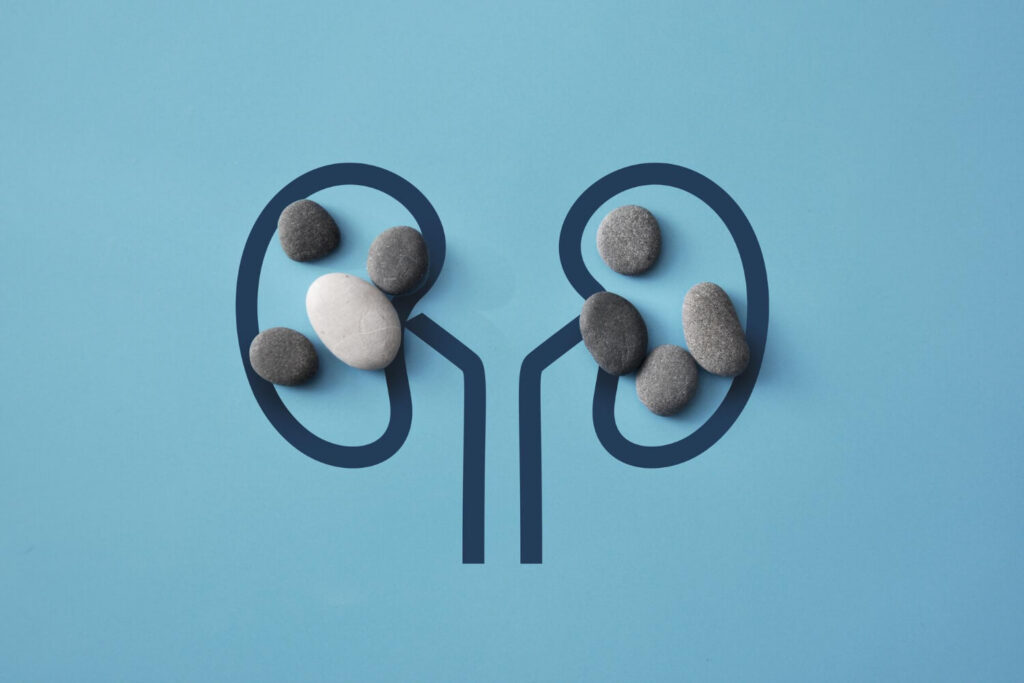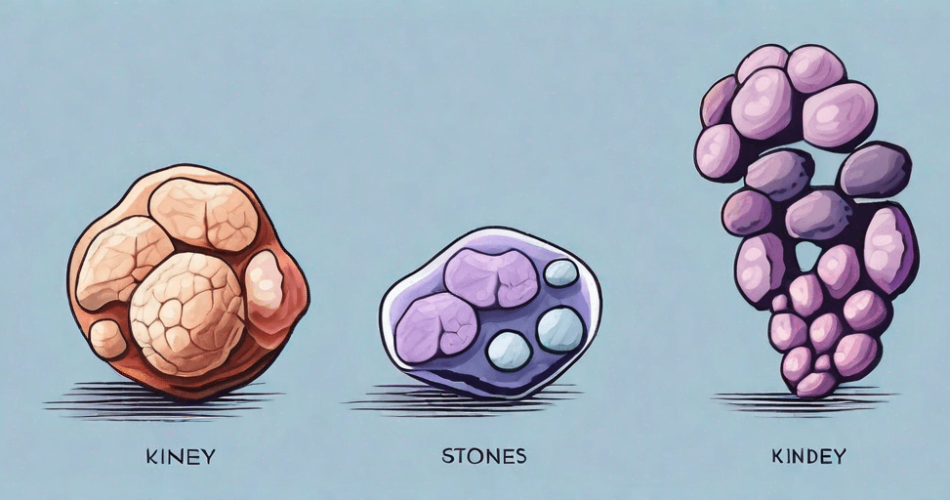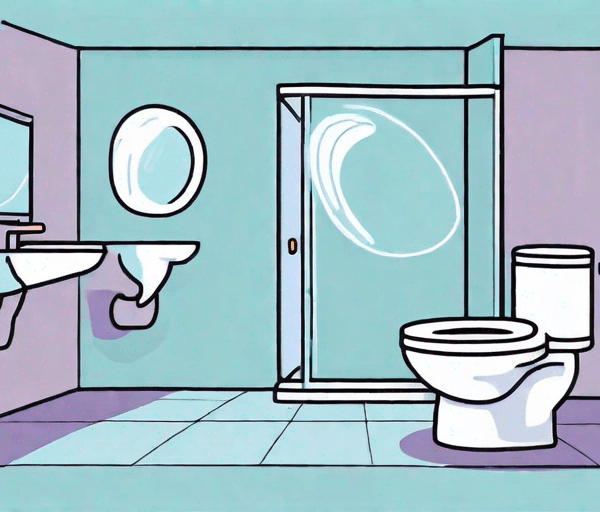Kidney stones are a common condition that affects many individuals worldwide. Understanding the various types of kidney stones, its risks and connected symptoms are all crucial for kidney stone patients. Uncover ever detail in this guide as we explore the different types of kidney stones.
Understanding Kidney Stones

Kidney stones, also known as renal calculi, are hard deposits that form in the kidneys. They can vary in size and shape. It usually ranges from as small as a grain of sand to as large as a golf ball. The most known substances in the urine are calcium, oxalate, and uric acid, Each of them can crystallize, resulting in the different types of kidney stones.
What are Kidney Stones?
Kidney stones are solid masses that develop in the kidneys. They are composed of various substances, including calcium, oxalate, uric acid, and struvite. These substances can combine to form crystals, which then grow into larger stones over time.
The Formation Process of Kidney Stones

The formation of kidney stones involves complex processes within the urinary system. It usually begins with the supersaturation of urine with substances like calcium, oxalate, or uric acid. When the concentration of these substances exceeds their solubility limit, they crystalize and adhere to other particles in the urine, forming small crystals.
As these crystals continue to accumulate, they can clump together and grow in size, eventually forming kidney stones. The growth of kidney stones can take months or even years, depending on various factors such as the individual’s hydration levels, diet, and overall health.
Factors like dehydration play a significant role in the formation of kidney stones. When the body is dehydrated, the urine becomes more concentrated, increasing the chances of crystal formation. Additionally, certain medical conditions, such as hyperparathyroidism or urinary tract infections, can also contribute to the development of kidney stones.
Common Symptoms and Complications

Kidney stones can cause various symptoms and complications that can significantly impact an individual’s quality of life. The most common symptom is severe pain, which typically occurs when a stone moves through the urinary tract. This pain, known as renal colic, is often described as excruciating and may radiate from the back to the lower abdomen or groin.
In addition to pain, kidney stones can also cause blood in the urine, a condition known as hematuria. The presence of blood can give the urine a pink, red, or brownish color. This indicates potential damage to the urinary tract.
Other symptoms include frequent urination, a strong urge to urinate, and a sensation of incomplete emptying of the bladder. These symptoms can be accompanied by nausea, vomiting, and fever, especially if there is an associated urinary tract infection.
While most kidney stones can be passed naturally through the urinary system, some may cause complications. For instance, larger stones may get lodged in the ureter, causing a blockage that obstructs the flow of urine. This can lead to severe pain, urinary tract infections, and potential kidney damage if left untreated.
In rare cases, kidney stones can also lead to the development of hydronephrosis. It is a condition characterized by the swelling of the kidney due to the accumulation of urine. This occurs when a stone obstructs the ureter and prevents urine from flowing properly.
Calcium Kidney Stones
Calcium kidney stones are the most common type of kidney stone, accounting for approximately 80% of all cases. They are typically composed of calcium oxalate or calcium phosphate.
When it comes to the composition of calcium stones, it is important to understand how they form. Calcium stones can develop when there is an excessive amount of calcium in the urine. This excess calcium combines with oxalate or phosphate, crystalizing and leading to the formation of stones. It is worth noting that certain medical conditions, such as hyperparathyroidism, can increase calcium levels in the urine and elevate the risk of developing calcium stones.
The Composition of Calcium Stones
Calcium stones can be further categorized into two types: calcium oxalate stones and calcium phosphate stones. Calcium oxalate stones are the most common, making up about 80% of all calcium stones. These stones form when there is an excess of calcium and oxalate in the urine. On the other hand, calcium phosphate stones are less common and are usually associated with certain medical conditions, such as renal tubular acidosis.
Understanding the composition of calcium stones is crucial for effective prevention and treatment strategies. By identifying the specific type of calcium stone, healthcare professionals can tailor their approach to better manage the condition.
Risk Factors for Calcium Stones
Several risk factors are associated with the formation of calcium kidney stones. While some of these factors are beyond an individual’s control, others can be modified to reduce the risk. It is important to be aware of these factors to take proactive steps towards prevention.
A family history of kidney stones is one of the non-modifiable risk factors. If someone in your family has had kidney stones, you may have a higher likelihood of developing them as well. Additionally, certain dietary choices can contribute to the formation of calcium stones. A diet high in oxalate and sodium increases the risk, as both oxalate and sodium can bind with calcium and promote stone formation.
Other risk factors include obesity, gastrointestinal diseases, and certain medications. Obesity can lead to changes in urinary patterns and increase the concentration of calcium in the urine. Gastrointestinal diseases, such as Crohn’s disease or gastric bypass surgery, can affect the absorption of calcium and oxalate, increasing the risk of stone formation. Furthermore, certain medications, such as diuretics or calcium-based antacids, can also contribute to the development of calcium stones.
Prevention and Treatment Options
Preventing the formation of calcium stones involves adopting certain lifestyle modifications and, in some cases, medical intervention. By implementing these strategies, individuals can reduce the risk of recurrent kidney stones.
One of the key prevention strategies is to drink plenty of water. Staying hydrated helps dilute the urine, reducing the concentration of calcium and other substances that can form stones. Additionally, reducing sodium and oxalate intake through dietary modifications can also be beneficial. Foods high in oxalate, such as spinach, rhubarb, and chocolate, should be consumed in moderation.
A balanced diet that includes adequate calcium intake is important as well. Contrary to popular belief, reducing calcium intake does not lower the risk of calcium stones. In fact, a diet low in calcium can increase the absorption of oxalate in the intestines, leading to higher levels of oxalate in the urine and potentially promoting stone formation.
In some cases, medication may be prescribed to prevent the recurrence of calcium stones. These medications can help regulate the levels of calcium and other substances in the urine, reducing the likelihood of stone formation. It is important to consult with a healthcare professional to determine the most appropriate treatment plan based on individual circumstances.
By understanding the composition of calcium stones, identifying risk factors, and implementing preventive measures, individuals can take control of their kidney health and reduce the likelihood of developing calcium kidney stones.
Uric Acid Kidney Stones
Uric acid kidney stones are another common type of kidney stone, accounting for approximately 5-10% of cases. These stones form when there is an excess of uric acid in the urine.
Understanding Uric Acid Stones
Uric acid stones develop when there are high levels of uric acid in the urine. Uric acid is a byproduct of purine metabolism, which is found in certain foods and naturally produced by the body. When the urine becomes too acidic or has insufficient urine volume, uric acid can crystallize, leading to stone formation.
Uric acid stones are more likely to form in individuals who have a genetic predisposition to overproduce uric acid or have difficulty excreting it. In addition to genetic factors, lifestyle choices can also contribute to the development of uric acid stones. Diets high in purines, such as red meat, organ meats, and seafood, can increase the levels of uric acid in the body. Excessive alcohol consumption, especially beer, can also raise uric acid levels.
Once uric acid stones form, they can vary in size and shape. Some stones may be small and pass through the urinary tract without causing any symptoms. However, larger stones can cause severe pain and discomfort as they travel through the ureter. The pain is often described as a sharp, stabbing sensation in the back or side, and may be accompanied by blood in the urine and frequent urination.
Who is at Risk?
Individuals who consume a diet rich in purines, have a history of gout or kidney disease, or have certain medical conditions (such as diabetes or metabolic syndrome) are more susceptible to developing uric acid kidney stones. Men are also more prone to developing uric acid stones compared to women.
People with gout, a type of arthritis caused by the buildup of uric acid crystals in the joints, are at an increased risk of developing uric acid kidney stones. Gout and uric acid stones are closely related, as both conditions involve the accumulation of uric acid in the body. Gout attacks can trigger the formation of uric acid stones, and individuals with a history of gout may experience recurrent kidney stone episodes.
Other medical conditions that can increase the risk of uric acid stone formation include certain types of cancer, such as leukemia and lymphoma, as well as conditions that cause chronic diarrhea or excessive sweating. These conditions can lead to dehydration and low urine volume, creating an environment favorable for uric acid crystallization.
Managing Uric Acid Stones
Managing uric acid stones involves lifestyle modifications and medications. Drinking plenty of fluids, especially water, helps to dilute urine and flush out excess uric acid. Staying well-hydrated is particularly important for individuals prone to uric acid stone formation.
In addition to adequate hydration, adopting a low-purine diet can help prevent the formation of uric acid stones. Foods that are high in purines, such as organ meats, shellfish, and certain types of fish, should be limited or avoided. Instead, individuals should focus on consuming a variety of fruits, vegetables, whole grains, and low-fat dairy products.
In some cases, medication may be prescribed to manage uric acid levels and prevent stone recurrence. Allopurinol, a medication that reduces the production of uric acid, is commonly used to lower uric acid levels in the body. Other medications, such as potassium citrate, may be prescribed to increase urine pH and make it less acidic, reducing the risk of uric acid crystallization.
Regular monitoring and follow-up with a healthcare provider is essential for individuals with a history of uric acid stones. By closely managing uric acid levels and making necessary lifestyle changes, the risk of stone formation can be significantly reduced.
Struvite Kidney Stones
Struvite kidney stones, also known as infection stones, are less common but potentially more problematic. They occur primarily due to urinary tract infections caused by certain types of bacteria.
What are Struvite Stones?
Struvite stones are composed mainly of magnesium ammonium phosphate and form in the urinary tract. These stones are often associated with the presence of certain bacteria, such as Proteus or Klebsiella, which produce substances that promote stone formation.
Causes and Risk Factors
One of the primary causes of struvite stones is urinary tract infections. When bacteria enter the urinary tract and multiply, they generate urine with high levels of ammonia and alkalinity. This creates an environment conducive to the formation of struvite stones.
Individuals who have a history of recurrent urinary tract infections, urinary tract abnormalities, or use urinary catheters are at higher risk of developing struvite stones.
Treatment Strategies for Struvite Stones
The treatment of struvite stones typically involves a combination of targeted antibiotics to eliminate the bacteria causing the infection and procedures to remove or break down the stones. Surgical intervention may be necessary in some cases to completely remove the stones and prevent future complications.
Conclusion
Understanding the different types of kidney stones and other related symptoms can help individuals take proactive steps to prevent and manage the condition. Every patient can have a different experience when dealing with this illness. That’s why it is crucial to consult with a doctor for an accurate diagnosis and tailored treatment plan.
Seek medical attention by booking a consultation today. Meet the right specialist who can address your kidney stone problems.



